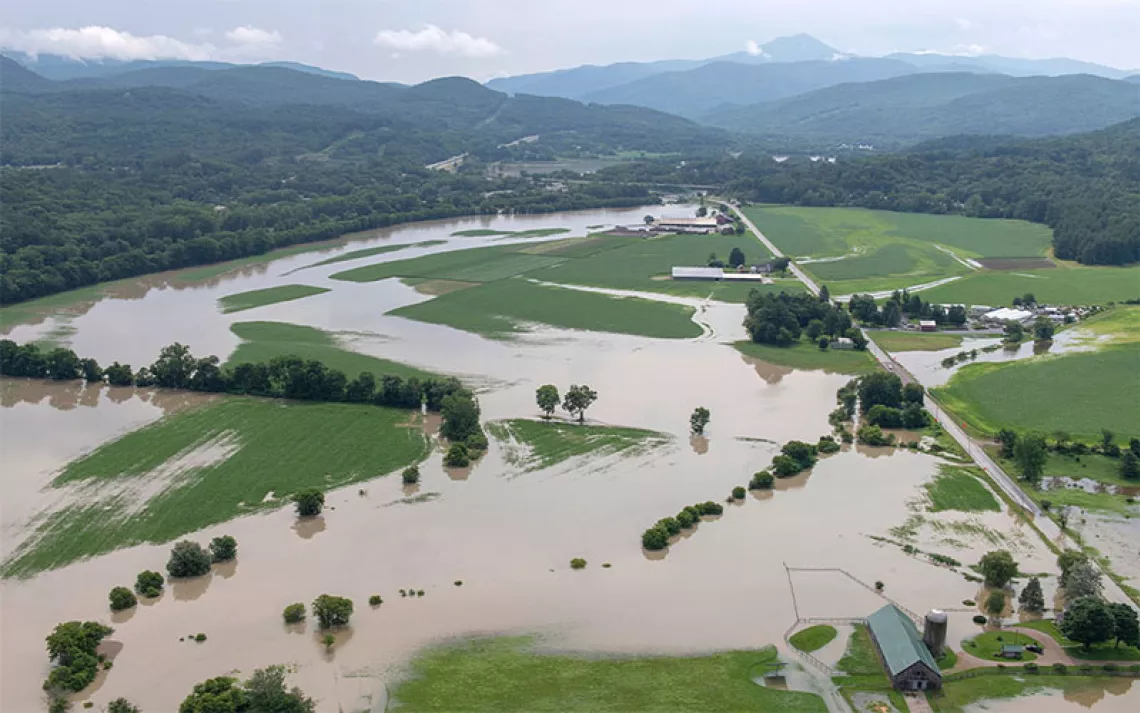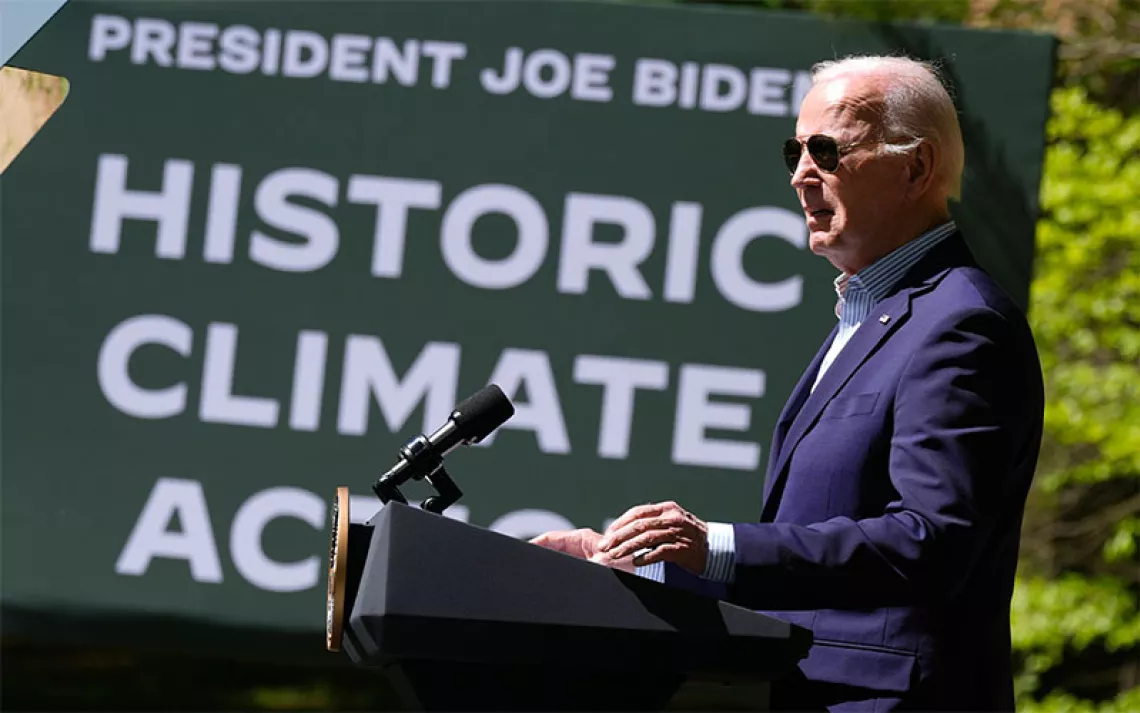10 Reasons to Feel Hopeful About Climate Change in 2019
Humanity’s on the brink, but signs are emerging that we’ll pull back

Photo by Gilltukha/iStock
In 2018, hurricanes, floods, fires, and droughts wreaked a level of destruction on the planet that, according to scientists, is just a taste of what is to come. In October, the International Panel on Climate Change issued a report stating that we have about 12 years to avoid catastrophic climate change. Meanwhile, global greenhouse gas emissions reached a record high in 2018. So is it still reasonable to hope that we can wean ourselves off fossil fuels in time to avert global calamity?
As David Roberts of Vox points out, that’s the wrong question. Climate change is happening now, and lots of change for the worse is already locked into place. But, as Roberts puts it, “we have some choice in how screwed we are.” Climate change isn’t a binary—safe or unsafe, screwed or not screwed—but rather a spectrum. That will remain true no matter how we respond to the task of reducing greenhouse gas emissions, or how severe the weather gets. “Yes, it’s going to get worse,” Roberts writes, “but nobody gets to give up hope or stop fighting.” Exactly right. Here, then, are 10 glimmers of hope that humanity will opt for less screwed over more screwed in 2019.
1. The Divestment Movement Keeps Growing
In 2012, Unity College, a small liberal arts school in Maine, announced that its trustees had voted to sell their shares in coal, oil, and gas companies. Six years later, more than 1,000 institutions have sold their investments in fossil fuels, bringing the total size of portfolios and endowments in the fossil fuel divestment campaign to nearly $8 trillion. At the start of 2018, New York City took the first steps to divest its $189 billion pension fund from fossil fuels. In July, Ireland became the first nation to do so. The fossil fuel industry is feeling the impact. In 2014, Peabody, the world’s largest coal company, warned investors that divestment could factor into declining profits; the company filed for bankruptcy in 2016. Earlier this year, Shell called divestment a material risk to its business. The divestment movement is forcing the fossil fuel industry to grapple with the real possibility of a future in which its stocks become stranded assets.
2. The Paris Agreement Holds Steady
Coming on the heels of President Trump’s announcement that the US intended to withdraw from the Paris Agreement, 2017’s UN Climate Talks (COP23) were full of defiance, as country after country reaffirmed their commitment to keeping the planet from warming more than 1.5°C (2.7°F). A year later, this global resolve has faltered but not failed. As countries met in Poland in November for COP24, delegates had to contend with the power vacuum left by a recalcitrant United States and its blatant support of the fossil fuel industry. Even worse, the US government’s climate denialism has emboldened backsliding from other countries, most notably Brazil. Nevertheless, the Paris Agreement still stands. Delegates at COP24 managed to negotiate a rulebook for how to measure the progress each country makes in reducing greenhouse gas emissions, ultimately reaffirming international cooperation in the effort to combat climate change.
3. The Rule of Law Still Rules
The Trump administration came into office intent on undoing decades of environmental protections and upending the Obama’s administration’s efforts to tackle climate change. There’s no denying that two years in, these policy goals are being realized. According to a recent New York Times report, as of December 2018, the Trump administration has eliminated, or is in the process of eliminating, a total of 78 environmental rules. But the administration has often fumbled in its attempts to unravel environmental legislation. It has failed to provide a credible legal argument for proposed changes or has skipped steps in the rule-making process, and the courts have ruled accordingly. For example, in July, a judge rescinded permits for the 300-mile-long Mountain Valley gas pipeline, declaring that federal officials had neglected to fully vet possible impacts on Jefferson National Forest. In November, a judge blocked the long-contested Keystone pipeline, ruling that the administration had “simply discarded prior factual findings related to climate change.” And federal courts have knocked back the administration’s efforts to rewrite regulations around the leakage of methane, a potent greenhouse gas. In short, judges are insisting that if the Trump administration wants to pulverize the planet, it has to at least be able to provide legal justification.
 Photo by Agaten/iStock
Photo by Agaten/iStock
4. Renewable Energy Is on the Rise
In case you missed it, renewable energy is thriving. A recent report from Wood Mackenzie predicts that clean energy technologies have now become so cost effective that they will replace fossil fuels as the main source of energy within the the next 20 years. Already, five states—California, Nevada, Hawaii, Massachusetts, and Vermont—generate 10 percent or more of their energy from solar energy. More than 100 cities and counties across the country have committed to transitioning to 100 percent clean energy. Germany produced enough renewable energy in the first half of 2018 to power every household in the country for a year, and Portugal ran on renewable energy for the entire month of March. In many places, it’s now cheaper to build and run new wind and solar farms than to run existing coal plants.
5. Coal Is Going, Going...
President Trump has promised to revive the coal industry, but, well, that hasn’t happened. If anything, the shrinkage of the coal industry has accelerated. The US Energy Information Administration reports that during Trump’s first two years in office, approximately 20 gigawatts of coal-fired electricity have been retired—that’s compared to a reduction of 15 gigawatts of coal during Obama’s first four years. The Sierra Club’s Beyond Coal campaign predicts that, based on the average rate of coal retirements over the past three years, all US coal plants will be closed by 2035. That means that the United States is on track to meet the IPCC’s requirement of totally phasing out coal in the US within 17 years.
6. Technology Is Advancing
It’s tempting to cross our fingers and hope that a technological fix for climate change will come along and we’ll be off the hook for doing the hard work of enacting deeper systemic change. This isn’t going to happen. However, the recent headline-grabbing climate reports do assume that what are called “negative emissions technologies” will play a crucial role in reducing emissions. Some of these, like reforestation and no-till agriculture, aren’t high tech at all and, if employed on a large scale, can do a lot to draw carbon out of the atmosphere. But a recent panel convened by the National Academies concluded that higher tech solutions like direct carbon capture (which likely involve storing extracted carbon deep in the ground) can and should be in the mix. The report stated that given recent breakthroughs, direct air capture of CO2 could become profitable within 10 years. Meanwhile, renewable energy technology keeps advancing, including innovations such as solar-panel-cleaning robots, taller wind turbines, solar panels that float, and better batteries for storing all that clean energy.
7. Transportation Is Headed in the Right Direction
Transportation is the biggest source of carbon pollution in the United States. Fortunately, there are some encouraging signs that a transportation overhaul is underway. In December, nine states—Connecticut, Delaware, Massachusetts, Maryland, New Jersey, Pennsylvania, Rhode Island, Virginia, and Vermont—and the District of Columbia announced a regional plan for limiting carbon emissions in the transportation sector. Meanwhile, California, along with 16 other states, is fighting the Trump administration to hold onto strict tailpipe standards for cars, trucks, and SUVs. As with renewable energy, economics may end up being the game changer. EVs are getting cheaper and more reliable, so much so that Wall Street Journal auto columnist Dan Neil concluded that buying a new internal-combustion engine car is now equivalent to buying a flip phone in an era of smartphones.
8. The Scales of Justice Are Tipping
It used to be if you were worried about global warming, you were supposed to change your lightbulbs and recycle. As the political movement to address climate change has evolved, so has the understanding that some players have made outsized contributions to the problem; researchers have established, for example, that the business practices of about 90 companies are responsible for nearly two-thirds of the observed increases in global surface temperatures. Now, an effort is underway to hold the fossil fuel industry responsible for its actions. In 2018, seven cities, counties, and states filed lawsuits against some of these companies, seeking to recover damages brought on by climate-change-related disasters. In November, West Coast crab fishermen sued 30 fossil fuel corporations, alleging that global warming has led to fishery closures and lost revenue. And the our Children’s Trust lawsuit—in which 21 young people are suing the US government for fueling global warming—is still making its way through the court system. Climate liability cases are a part of a global trend: Lawsuits are ongoing in the Netherlands, Peru, the Philippines, Canada, and other countries.

Sunrise Movement protest inside the office of Representative Nancy Pelosi | Photo by Michael Brochstein/Sipa USA (SIPA via AP Images)
9. The Political Winds Are Shifting
When it comes to dealing with climate change, there are few obstacles to progress as great as the hot mess of greed, denial, and incompetence that is the current US federal government. Happily, that is not the whole political story in the United States. The grassroots opposition to President Trump came to fruition this past November, sweeping a historic number of Democrats (many of them women and people of color) into the House of Representatives and establishing a formidable counterforce to the Trump administration. One of the most famous new representatives, Alexandria Ocasio-Cortez of New York, is already busy advocating for a Green New Deal—basically, an enormous policy and stimulus package that would tackle both climate change and income inequality. Election night brought lots of green victories on the state and local level as well, with pro-environment governors elected in Illinois, New Mexico, Kansas, Michigan, and Pennsylvania. This is important because, as Sierra Club Beyond Coal campaign director Mary Anne Hitt points out, states and cities are where the decisions are made in this country about how to produce electricity.

Swedish activist Greta Thunberg | Photo by AP Photo/Czarek Sokolowksi
10. Youths Are on the March
Every Friday, 15 year-old Greta Thunberg skips school to sit outside the Swedish Parliament and protest the failure of politicians to act on climate change. She has inspired thousands of kids around the world to do the same. At the end of 2018, 15,000 Australian students marched against plans to build a massive coal mine in Queensland. American kids are agitating for change too. In July, 16-year-old Jamie Margolin led hundreds of youth activists in a march in Washington, D.C., to denounce inaction on climate change. In November, young people from the Sunrise Movement occupied the offices of Representatives Nancy Pelosi, Steny Hoyer, and Jim McGovern to push for the establishment of the Green New Deal. Righteously pissed that adults are not acting in their best interests, young people around the globe are taking matters into their own hands. As Thunberg put it in a Guardian op-ed, “We can no longer save the world by playing by the rules because the rules have to be changed.”
Here's to changing all the rules in 2019.
 The Magazine of The Sierra Club
The Magazine of The Sierra Club



